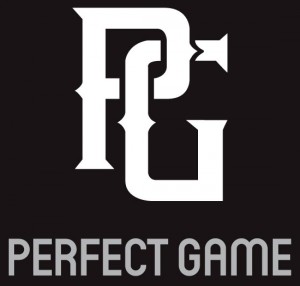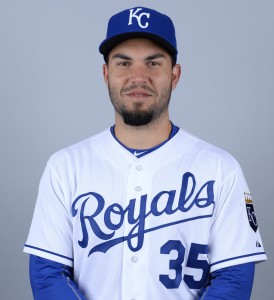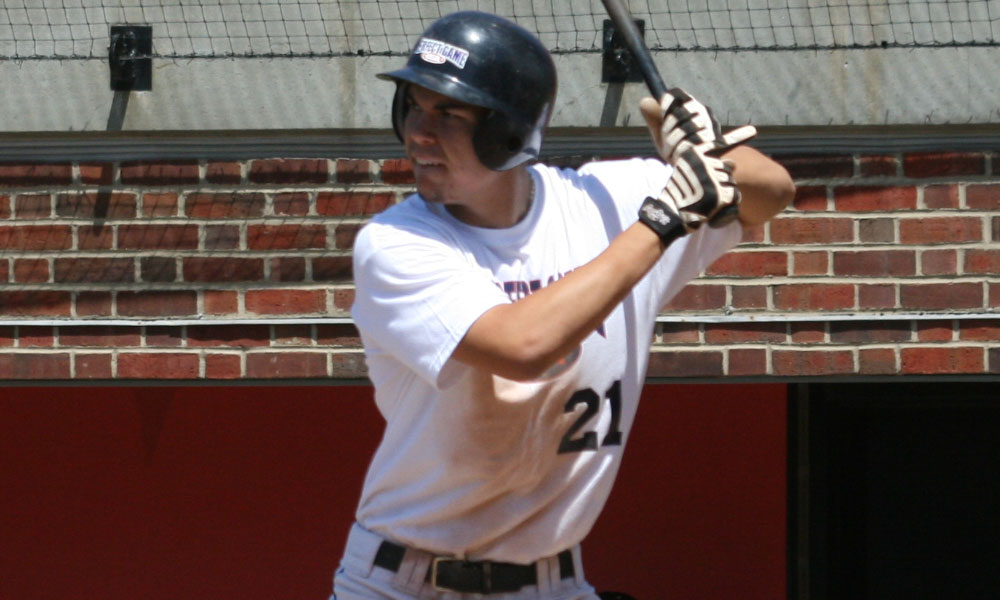Feature Photo: Eric Hosmer (Photo by Perfect Game)
 Perhaps the best way to start a look at Eric Hosmer’s development before he became a professional, and eventually one of the heroes of the 2015 World Series Champion Kansas City Royals, is to stay in the present and make a tight present comparison between Hosmer and Chicago Cubs outfielder Jason Heyward (who I profiled earlier in this series).
Perhaps the best way to start a look at Eric Hosmer’s development before he became a professional, and eventually one of the heroes of the 2015 World Series Champion Kansas City Royals, is to stay in the present and make a tight present comparison between Hosmer and Chicago Cubs outfielder Jason Heyward (who I profiled earlier in this series).
Although Heyward was the 14th overall pick in the 2007 MLB First-Year Player Draft, and Hosmer the third overall pick in the 2008 MLB Draft, they are nearly identical in age. Heyward was exceptionally young for his school grade and could have easily been a member of the class of 2008. Their birthdates in 1989 are separated by about 10 weeks.
Then take a look at what they’ve accomplished as big leaguers, ignoring the big dollar numbers on Heyward’s new contract, and Hosmer’s postseason accomplishments. Heyward’s basic career stat line reads .268-97-352 in 835 games, with three Gold Gloves in right field. Hosmer’s line reads .280-77-368 in 728 games, and he’s also got three Gold Gloves at first base.

Eric Hosmer, 1B, Royals (Photo by Ron Vesely/MLB Photos via Getty Images)
And if Hosmer builds on his .297-18-93 numbers last season, and at age 26 potentially appears in another World Series, he’ll be looking forward to a Heyward-sized bank account when he becomes a free agent after the 2016 season. It’s even possible that his Royals might have to face off against Heyward’s Cubs to win it.
The comparison can be stretched plenty further: the 6’4″, 225 pound Hosmer vs. the 6’5”, 245 pound Heyward; both left-handed hitters and throwers; both excellent defensively; both with background as Perfect Game All-Americans; both as 90+ mph high school pitchers – their games are extensive and consistent across the board.
When delving into Hosmer’s development history, the most important similarity between the two is that both Heyward and Hosmer were expected to be big-time power hitters as professionals. And as 26-year-olds, they still have the time to develop that ability. But neither has fulfilled, as of yet, the promise of the power tool that they showed off in high school.
A native of southeastern Florida who attended American Heritage High School, a consistent top program in one of the most talent intensive areas of the country, Hosmer was a nationally known prospect very early in his high school career. He made his first PG appearance after his freshman year at the 2005 Sunshine East Showcase, and he shined. The report on the 6’1”, 185-pounder at the time read:
He has a very good baseball body and still has years to mature. Defensively he has smooth actions with athletic movements around the first base bag. He also has good arm strength for a 1B with good carry. At the plate he hits from the left side with an open stance and very good bat speed. His swing is very fundamentally sound and he looks very comfortable in the batter’s box. Hosmer has the adjustability with his hands to go with the pitch and drive the ball to the opposite field. He consistently makes solid contact, and has projectable power, and should be a middle of the order run producer. On the mound he throws from a 3/4 arm slot with good mechanics. His fastball topped out at 83 mph, and has projectable velocity. He also showed a feel for his secondary pitches that are still developing. Hosmer projects to be a top two-way prospect, and is a must-follow.
Hosmer continued to grow and develop through high school and was always among the top ranked prospects in the 2008 class. The all-important summer and fall before his senior year started at the 2007 PG National Showcase in Cincinnati, and the report I wrote from there pretty much says it all about Hosmer’s combination of hitting ability, power, and defensive skills, and even his arm strength on the mound.
Eric Hosmer is a 2008 1B/P with a 6’4”, 210 lb. frame from Cooper City, FL who attends American Heritage HS. He has a big league body, with excellent strength and proportions and is in top level shape. Hosmer did nothing in Cincinnati to make anyone question that he is the top hitter in the 2008 class. He is a pure hitter with bat speed, confidence and a very mature ability to adjust to different pitches and make solid contact to all fields. Hosmer realizes he doesn’t have to show his light tower power every swing but it’s there if he sees his pitch. There haven’t been many better in the last generation of high school hitting prospects in our opinion. Lost in the talk about Hosmer’s hitting ability as a prospect are his other tools. He is an outstanding defensive first baseman with light feet and soft hands and polished balance round the bag. He threw 92 mph from first in infield drills, which is unheard of from a first baseman, and we’ve heard he’s thrown up to 94 mph this summer from the mound from the left side, although he didn’t pitch in Cincinnati. Hosmer has a verbal commitment to Arizona State but he should be one of the top picks in the 2008 draft if nothing steps in his way.
The rest of the 2007-08 season continued along the same lines. He won the Most Valuable Player award at both the Connie Mack World Series and the WWBA World Championships and played in the Aflac All-American Game. Hosmer then went out and hit .471-11-27 with 31 walks as a senior at American Heritage, along with posting a 0.40 ERA on the mound and striking out 32 in 17 IP. He was named the Florida Player of the Year for the second time, and American Heritage won the state championship with a 31-2 record.
From a scouting perspective, a number of things were constants with evaluating Hosmer. One, of course, was his power. He showed it to all fields during games, and he was known to go yard to the opposite field against quality pitching, including one memorable home run in a playoff game in Jupiter in 2007. His present status as perhaps the best defensive first baseman in the game comes as little surprise based on what his skills were as a teenager. But most of all, Hosmer was always comfortable on the field. He slowed the game down. He was very comfortable taking pitches and hitting behind in counts. He had played as much baseball as any 18-year-old in the country had and it came easily to him while he was still playing hard.
As was mentioned in last week’s Buster Posey piece, the 2008 MLB Draft was loaded, and the top five picks, Tim Beckham, Pedro Alvarez, Hosmer, Brian Matusz and Posey, were pretty well established in that grouping. Hosmer had retained Scott Boras as his advisor, which complicated his signability for many teams, but the Royals had successfully negotiated with Boras in signing their 2007 second overall pick, Mike Moustakas, and they weren’t intimidated. Hosmer eventually signed for a $6 million bonus to forgo his scholarship to Arizona State University.
What happens with Hosmer over the next year will be very interesting to follow, both from the perspective of how he performs individually and how the Royals follow up on their 2015 season. Lurking and looming in the background, and perhaps in Hosmer’s October future, could be the shadow of Jason Heyward. Just as it has been in his past.


